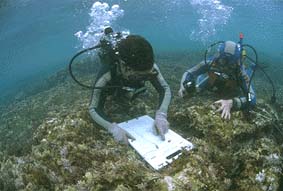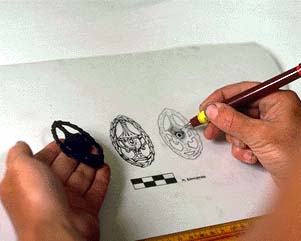Maritime Archaeology Department
Western Australia Maritime Museum
Maritime archaeological collections from the sea floor through
preservation to display in the Museum Galleries.
Archaeological material recovered from historic shipwrecks on the Western
Australian coast was a catalyst in the development of the Western Australian Maritime Museum. The
Museum is one of the few museums in the world specifically oriented to the preservation and display
of maritime archaeological material.
 Objects
from shipwrecks, including the vessels themselves, are rarely found in pristine condition. Mostly,
they are slightly damaged, broken into hundreds of small pieces or badly eroded. To discover an
intact fragile artefact buried in the sea-bed is a most exciting experience! Objects
from shipwrecks, including the vessels themselves, are rarely found in pristine condition. Mostly,
they are slightly damaged, broken into hundreds of small pieces or badly eroded. To discover an
intact fragile artefact buried in the sea-bed is a most exciting experience!
Part of the work of the Maritime Archaeology Department is to register, document
and research the shipwreck collections in order to identify the various components of the ship –
its hull structure, fastenings, fittings etc., and its contents – ship's equipment, stores, cargo,
personal possessions of the crew, and so on.
Documentation begins at the shipwreck site, as soon as objects are raised, and
continues back at the Museum. Gathering information from archival and other sources, and piecing it
together can be very time consuming. Likewise, fitting together broken pottery sherds or fragments
of inorganic and organic materials takes many hours of patient work. But this is often the only way
to discover what the original objects were. Once the identity and origin of the artefacts are
established, an interpretation of the way particular ships were built, of life on board, trade and
other commercial shipping activities, can then be developed. The information is incorporated into
Museum exhibits and publications.
 The
function or use of individual objects found on a shipwreck site is frequently determined by
associated artefacts. Groups (or assemblages) of artefacts may therefore have a particular
archaeological significance and, for this reason, are exhibited together: we could not interpret
the meaning of one without the other. Displaying maritime archaeological material is a specialised
task since many artefacts have lost their original strength and need to be carefully supported.
Others have been reconstructed to demonstrate their original form. The maritime archaeological
collection contains material dating from the early 17th century through to the late 19th century.
It provides tangible evidence of the early presence of English, Dutch and American seafarers on the
west coast of Australia (Trial 1622,
Batavia 1629,
Vergulde Draeck 1656,
Zuytdorp 1712,
Zeewijk 1727 and Rapid 1811), of shipping activity associated with British colonisation of
Western Australia and of the development of the State. The
function or use of individual objects found on a shipwreck site is frequently determined by
associated artefacts. Groups (or assemblages) of artefacts may therefore have a particular
archaeological significance and, for this reason, are exhibited together: we could not interpret
the meaning of one without the other. Displaying maritime archaeological material is a specialised
task since many artefacts have lost their original strength and need to be carefully supported.
Others have been reconstructed to demonstrate their original form. The maritime archaeological
collection contains material dating from the early 17th century through to the late 19th century.
It provides tangible evidence of the early presence of English, Dutch and American seafarers on the
west coast of Australia (Trial 1622,
Batavia 1629,
Vergulde Draeck 1656,
Zuytdorp 1712,
Zeewijk 1727 and Rapid 1811), of shipping activity associated with British colonisation of
Western Australia and of the development of the State.
By Jeremy Green
Western Australian Maritime Museum
Cliff Street, Fremantle
WA 6160, Australia
Tel: +61-9-431 8444, Fax: +61-9-335 7224
Related links
Article published on Nordic Underwater Archaeology, Sep '99
Text & photos © Western Australian Maritime Museum |